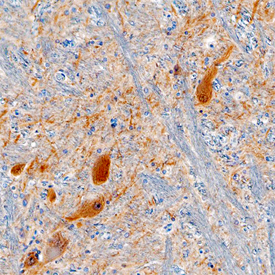Human/Mouse Gephyrin/GPHN Antibody Summary
Ala2-Ser188
Accession # Q9NQX3
Applications
Please Note: Optimal dilutions should be determined by each laboratory for each application. General Protocols are available in the Technical Information section on our website.
Scientific Data
 View Larger
View Larger
Detection of Human and Mouse Gephyrin/GPHN by Western Blot. Western blot shows lysates of IMR-32 human neuroblastoma cell line and Neuro-2A mouse neuroblastoma cell line. PVDF membrane was probed with 2 µg/mL of Mouse Anti-Human Gephyrin/GPHN Monoclonal Antibody (Catalog # MAB7519) followed by HRP-conjugated Anti-Mouse IgG Secondary Antibody (Catalog # HAF007). A specific band was detected for Gephyrin/GPHN at approximately 90 kDa (as indicated). This experiment was conducted under reducing conditions and using Immunoblot Buffer Group 1.
 View Larger
View Larger
Gephyrin/GPHN in Human Brain. Gephyrin/GPHN was detected in immersion fixed paraffin-embedded sections of human brain (medulla) using Mouse Anti-Human/Mouse Gephyrin/GPHN Monoclonal Antibody (Catalog # MAB7519) at 15 µg/mL overnight at 4 °C. Tissue was stained using the Anti-Mouse HRP-DAB Cell & Tissue Staining Kit (brown; Catalog # CTS002) and counterstained with hematoxylin (blue). Specific staining was localized to neuronal cell bodies. View our protocol for Chromogenic IHC Staining of Paraffin-embedded Tissue Sections.
Reconstitution Calculator
Preparation and Storage
- 12 months from date of receipt, -20 to -70 °C as supplied.
- 1 month, 2 to 8 °C under sterile conditions after reconstitution.
- 6 months, -20 to -70 °C under sterile conditions after reconstitution.
Background: Gephyrin/GPHN
Gephyrin (GPHN, from gamma epsilon φυρ alpha, the Greek word for bridge; also known as molybdopterin adenyltransferase) is a 90-94 kDa member of both the MoaB and MoeA families of proteins. It has limited expression, being found in hepatocytes and neurons. In neurons, gephyrin is a postsynaptic density cytoplasmic protein that interacts with the subunits of glycine and GABA-A receptors. This interaction is mediated by the ability of gephyrin to form hexameric lattices that act as scaffolds that link the subunits of the two inhibitory receptors to the cell's underlying tubulin network. In addition, the gephyrin lattice may also interact with NLG-1 and -2, suggesting a role for gephyrin in the regulation of glutamatergic synapses. Gephyrin is also known to participate in the synthesis of molybdenum cofactor. This cofactor binds molybdenum, making it available to sulfite and aldehyde reductase. Human gephyrin is 736 amino acids (aa) in length. It contains a 181 aa N-terminal G-domain that possesses MPT Mo-transferase activity (aa 14-166) and a homotrimer interface motif, followed by a 420 aa C-terminal region (aa 319-738) that contains an MPT adenyltransferase domain (aa 326-736) with an embedded homodimerization motif. There are at least five utilized Ser/Thr phosphorylation sites. Multiple splice variants exist, and represent peptide insertions at multiple sites. There is a 13 aa insertion after Glu98, a 33 aa insertion after Ser243, and 15, 19, 21 and 24 aa insertions after Lys288. Over aa 2-188, human and mouse Gephyrin are identical in amino acid sequence.
Product Datasheets
FAQs
No product specific FAQs exist for this product, however you may
View all Antibody FAQsReviews for Human/Mouse Gephyrin/GPHN Antibody
There are currently no reviews for this product. Be the first to review Human/Mouse Gephyrin/GPHN Antibody and earn rewards!
Have you used Human/Mouse Gephyrin/GPHN Antibody?
Submit a review and receive an Amazon gift card.
$25/€18/£15/$25CAN/¥75 Yuan/¥2500 Yen for a review with an image
$10/€7/£6/$10 CAD/¥70 Yuan/¥1110 Yen for a review without an image

